
While there are hundreds, if not thousands, of fabulous knitting stitch patterns in the world, in this article we are going to take a look at reversible stitches. Nothing is more frustrating that trying out a simple scarf to learn a new stitch pattern and then realizing the contortions you’ll have to go through when

While there are hundreds, if not thousands, of fabulous knitting stitch patterns in the world, in this article we are going to take a look at reversible stitches. Nothing is more frustrating that trying out a simple scarf to learn a new stitch pattern and then realizing the contortions you’ll have to go through when wearing it to make sure what turned out to be an unfortunate looking wrong side of the work is never showing!
What is Reversible Knitting?
So what do we mean by reversible? In some cases it means that both sides of the project are identical, or at least close enough to it that a casual glance won’t prove otherwise, but sometimes it’s a matter of just wanting both sides to look great – even if they don’t look the same.
Depending on the type of reversible knitting you’d like to achieve, there are several different stitches than can help. Below I’ve shown a few of my favorites. It all starts by selecting your favorite texture-focused stitch.
Texture-Focused Stitches
Texture-focused stitches contain a small number of stitches/rows in the repeat and tend to look great on both sides. Think garter stitch, ribbing, seed stitch, linen stitch, checkerboard and moss or double moss stitch, for example. Because the stitch pattern is small there is hardly any difference between right and wrong side.
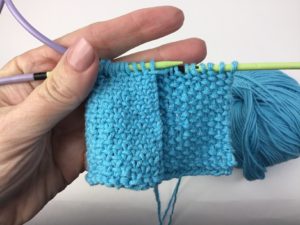
Here is a swatch of some linen stitch showing both the front and the back – they are nearly indistinguishable.
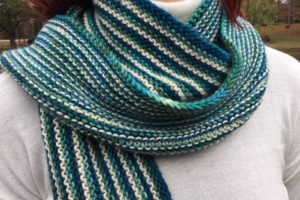
In this scarf, worked in garter stitch with a color change every two rows, texturally the front and back are identical, color wise they are different but both look terrific in their own way. The visual contrast in the sides adds to the fun of wearing it, instead of detracting from your look.
Pro: Simple, mindless stitching can be great sometimes when you need a brain break.
Con: Simple, mindless stitch can be boring when you need a challenge.
Double Knitting
Of course the obvious way to make sure your work looks the same on both sides is to indulge in a little double knitting. Double knitting is a technique in which the knitter works with two strands of yarn, alternating knit and purl stitches (and colors if you are also doing colorwork!) so that a dense fabric is created in which both sides look like the smooth side of stockinette stitch. In a solid color or two, you have a simple look, but you can also switch colors back and forth to pick out a color pattern in which one side is an exact negative version of the other side – your pattern will be color A with color B accents on one side, and color B with color A accents on the reverse.
Pro: Absolutely fabulous on both sides.
Con: The fabric is dense – not a great choice for garments for people in milder climates.
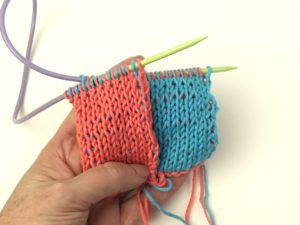
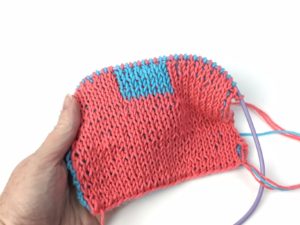
Cable Knitting
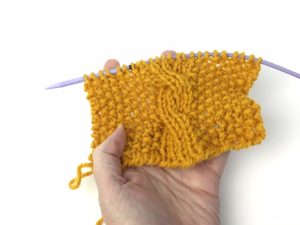
You can adapt almost any cable to this type of treatment, but be aware of the width of your work. Because ribbing, which is the easiest fix, pulls the work in widthwise you may want to add some stitches to each leg to accommodate that narrowing. For example, if I am looking at a stitch pattern that manipulates three legs with three stitches in each leg, I may change to three legs with four stitches in each leg to keep the proportions attractive. While most traditional cable legs have an odd number of stitches in them, ribbed cables seem to lay better with an even number.
Cables can be a little tricky ― they are, by nature, a stitch pattern in which the right side looks amazing and textural, and the wrong side looks like twisted nothing. One way to change that is to make each leg of the cable reversible, by working the leg in a ribbing (most common) or another reversible stitch.
If you have set up your adjusted cable in the traditional manner, with the cable panel offset by reverse stockinette stitches and bordered by stockinette sections, the work won’t be identical on both sides – one side will feature stockinette more prominently and the other reverse stockinette. If you want work that looks exactly the same on both sides, consider placing the cable in a stitch pattern that’s reversible on its own like garter stitch or seed stitch.
Now that you have these tricks up your sleeve – go forth and knit fabulous scarves! Scarves are a terrific way to master a new stitch pattern because you can focus on the stitch counts rather than worrying about shaping, and with a little planning, your scarf will look fabulous even on the run!

